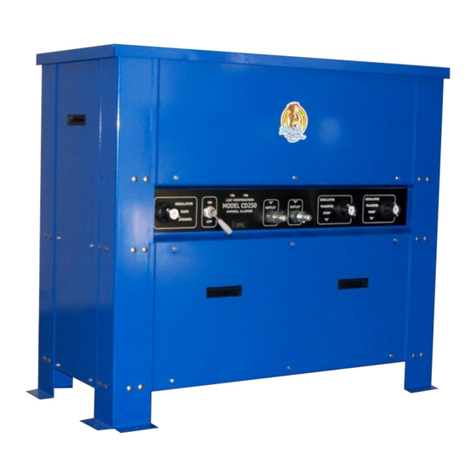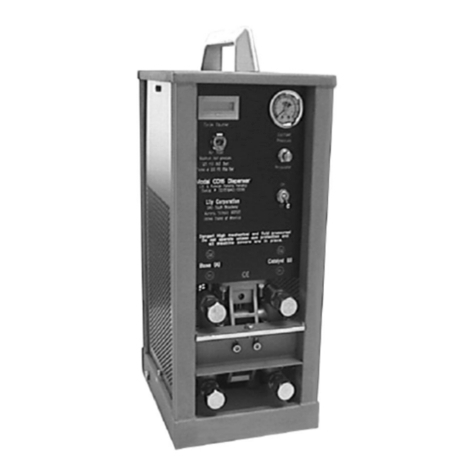
CD65ServiceManual: Ver.1.2,Page 8
Clean-up
The GustoPurge tank (Page#32) is usedto cleanhoses, mixers, hosemanifolds, valves,and other components
exposedto catalyzed resin. Complete steps 1 and 2 below tocharge theGusto Purgetank beforestarting injection.
Itisa precaution thatallows clean-up inthe event theairsupply islostdue to compressorfailure. Withthe Gusto
Purgetank fully chargedwithair,there is sufficientenergywithin the tank tocleanupthemajorcomponents.
1. Vent the tank by rotating theselector valveso thatit pointsaway fromthe adapterblock,
andtowardsthe bronzefilter. Removethe lid andpour about one-halfgallon of Acetoneor
MethylEthylKetone (MEK) solventinto the tank. Donot use petroleumbasedsolvents
suchastoluol,xylol,mineralspiritsor naptha, as theywilldestroythelidseal. Donot fill the
tank,asthiswillreducethevolumeofair available for anemergencyclean-up.
2. Replacethe lidand secure it with itsbale. Rotate theselector valve 90 degrees sothat it
isclosed to theinlet and outlet. Connectthe airsupply and pressurizethe tankat the maxi-
mumpressureavailable. Setthe tank asideuntiltimeto clean up.
Mostepoxyresinscanbeleftwithinasystemindefinitely. How-
ever,there isa very important step to be takenat shut-downif (a),
alowviscosityresinis being used, and(b), amixerormanifoldis
fixeddirectlytothe outletfittingsofthe Cocomodule. Theproce-
dureiscalled“burping”.
Burpingisnecessary because thebase and catalystcomponentsof
mostthinresinshaveamuchdifferentspecificgravity. Likevinegar
andoilin saladdressing, one isheavierthanthe other,andquickly
sinksto the bottom: the base component tends to sink beneath the
catalyst.Whenthecomponentshovertogetherwithinamixer or
manifoldfixedtotheoutletvalves,itispossiblewithina very few
minutesforthe base topond out beneaththecatalyst, entering the
catalystoutletvalvewithcostlyresultsasithardensovernight.
Toburp the unit,simplydispenseafew ounces ofmaterialintoa
wastecontainerimmediatelyafterremovingthemixerormanifold.
Thiswillflushanybaseresinwhichmayhaveenteredthe catalyst
fittingorvalve.
Heavier base
resin ponded
into catalyst
valvefrommixer
Shut Down
OPERATION cont.
Becausetheresincomponents arenotjoinedwithin thedispenser, no internalclean-upis required. And unlessyouare
usingasingle outlethosewith aSSOControl Valve, or a mixerthat is notdisposable, there isno external clean-up
otherthan those minor tasks cited on Page 7, and you can proceed directly to Page10 forfurther information. Youdo
notneedtheinformationbelow. Butifyouare dispensing throughasinglehose or anon-disposablemixer, you need
thefollowinginformation.





























